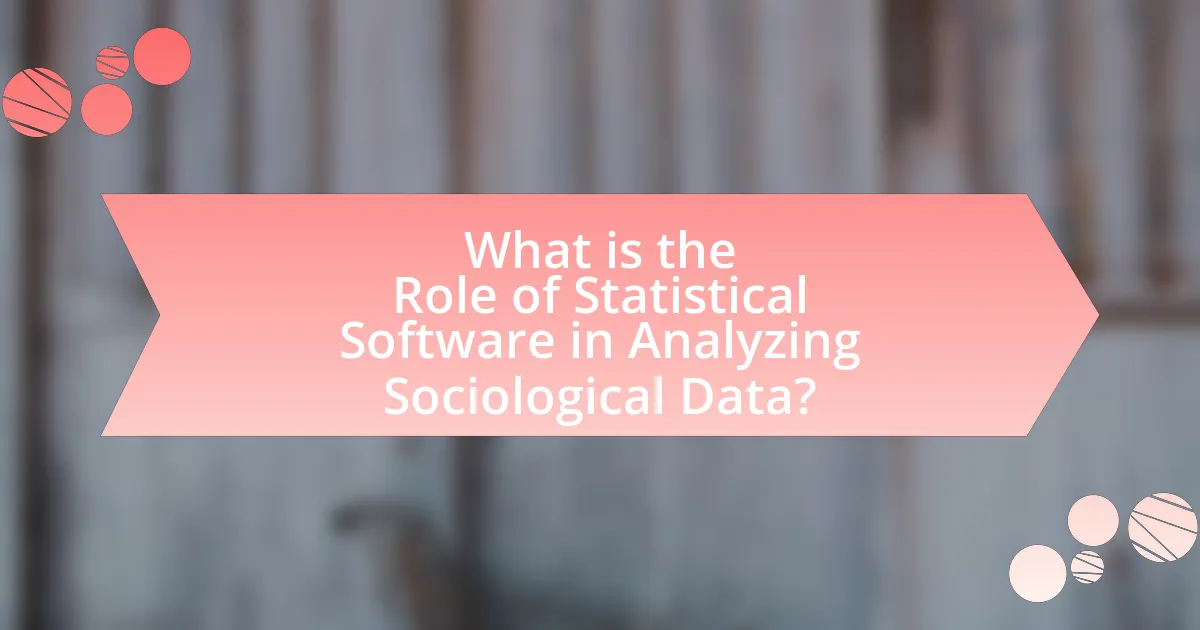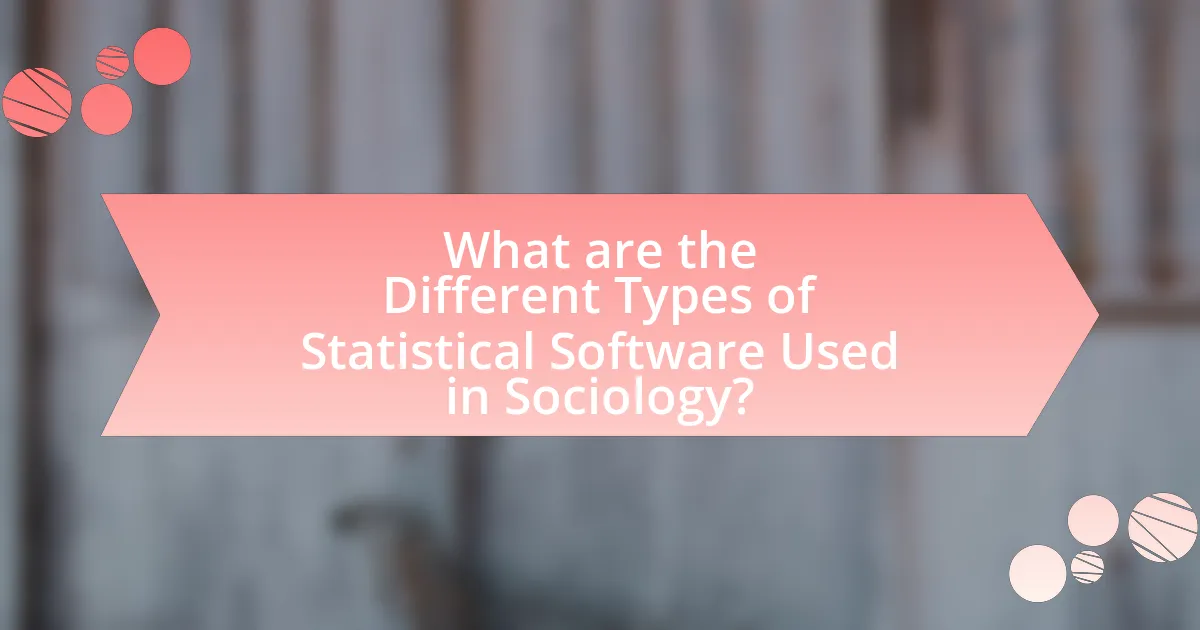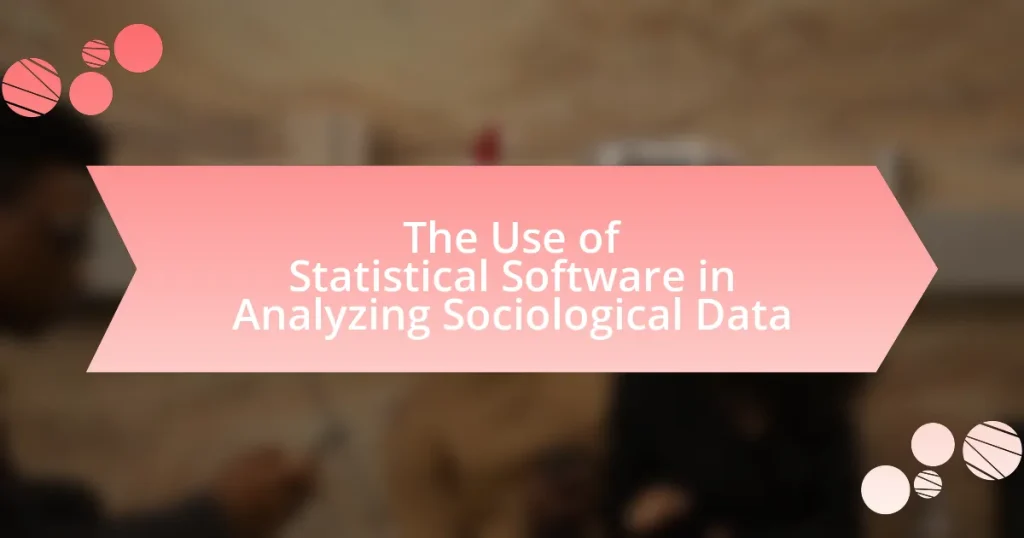Statistical software is essential for analyzing sociological data, providing tools for data management, statistical analysis, and visualization. Programs such as SPSS, R, and Stata enable sociologists to efficiently handle large datasets, perform complex statistical tests, and accurately interpret results, including regression and multivariate analyses. The article explores the various types of statistical software used in sociology, their functionalities, and the best practices for ensuring data integrity and reproducibility. It also addresses the challenges sociologists face without these tools and highlights the importance of user experience and training in selecting appropriate software for research needs.

What is the Role of Statistical Software in Analyzing Sociological Data?
Statistical software plays a crucial role in analyzing sociological data by providing tools for data management, statistical analysis, and visualization. These software programs, such as SPSS, R, and Stata, enable sociologists to efficiently handle large datasets, perform complex statistical tests, and interpret results accurately. For instance, statistical software can conduct regression analyses, which help identify relationships between variables, a common requirement in sociological research. Additionally, the use of statistical software enhances the reproducibility of research findings, as it allows for standardized methods and procedures. This is supported by the fact that many sociological studies rely on quantitative data, necessitating robust analytical capabilities that statistical software provides.
How does statistical software facilitate sociological research?
Statistical software facilitates sociological research by enabling researchers to efficiently analyze large datasets, identify patterns, and draw meaningful conclusions. This software provides tools for data management, statistical analysis, and visualization, which are essential for understanding complex social phenomena. For instance, programs like SPSS and R allow sociologists to perform regression analysis, factor analysis, and other statistical tests that reveal relationships between variables. The ability to handle vast amounts of data quickly and accurately enhances the reliability of research findings, as demonstrated by studies that utilize these tools to analyze survey data or demographic information, leading to insights that inform social policy and academic discourse.
What types of statistical analyses can be performed using this software?
This software can perform various types of statistical analyses, including descriptive statistics, inferential statistics, regression analysis, and multivariate analysis. Descriptive statistics summarize data characteristics, inferential statistics draw conclusions from sample data, regression analysis examines relationships between variables, and multivariate analysis explores multiple variables simultaneously. Each of these analyses is essential for understanding sociological data, as they provide insights into patterns, relationships, and trends within the data set.
How does statistical software enhance data visualization in sociology?
Statistical software enhances data visualization in sociology by providing advanced tools for creating clear and informative graphical representations of complex data sets. These software programs, such as SPSS, R, and Stata, allow sociologists to transform raw data into visual formats like charts, graphs, and maps, which facilitate the identification of patterns, trends, and relationships within social phenomena. For instance, R offers packages like ggplot2 that enable users to produce high-quality visualizations tailored to specific analytical needs, thereby improving interpretability and communication of sociological findings. Additionally, statistical software supports the integration of statistical analysis with visualization, allowing for dynamic updates of visual outputs as data is manipulated, which enhances the overall analytical process in sociological research.
Why is statistical software essential for sociologists?
Statistical software is essential for sociologists because it enables them to efficiently analyze complex data sets and derive meaningful insights. Sociologists often work with large volumes of quantitative data, which require sophisticated statistical techniques for analysis. For instance, software like SPSS or R allows sociologists to perform regression analysis, factor analysis, and other statistical tests that are crucial for understanding social patterns and relationships. The ability to visualize data through graphs and charts further enhances the interpretation of results, making it easier to communicate findings to both academic and public audiences.
What challenges do sociologists face without statistical software?
Sociologists face significant challenges without statistical software, primarily in data analysis efficiency and accuracy. The absence of such tools complicates the handling of large datasets, making it difficult to perform complex statistical analyses that are essential for drawing valid conclusions. For instance, manual calculations increase the risk of human error and can lead to inaccurate interpretations of sociological phenomena. Additionally, without statistical software, sociologists may struggle to visualize data effectively, hindering their ability to communicate findings clearly. This limitation can affect the overall quality of research and its impact on policy-making and social understanding.
How does statistical software improve the accuracy of sociological findings?
Statistical software improves the accuracy of sociological findings by enabling precise data analysis through advanced statistical techniques. These software programs facilitate the handling of large datasets, allowing researchers to apply complex models such as regression analysis, factor analysis, and multivariate analysis, which enhance the reliability of results. For instance, software like SPSS and R can perform calculations that minimize human error and provide robust statistical outputs, ensuring that findings are based on sound empirical evidence. Additionally, statistical software often includes built-in functions for testing assumptions and validating models, which further strengthens the credibility of sociological research outcomes.

What are the Different Types of Statistical Software Used in Sociology?
The different types of statistical software used in sociology include SPSS, R, Stata, SAS, and NVivo. SPSS is widely utilized for its user-friendly interface and robust statistical capabilities, making it suitable for social science research. R is favored for its flexibility and extensive package ecosystem, allowing for advanced statistical analysis and data visualization. Stata is known for its powerful data management and statistical analysis features, particularly in econometrics and biostatistics. SAS is utilized for its advanced analytics, business intelligence, and data management capabilities, often in large-scale research projects. NVivo is specifically designed for qualitative data analysis, enabling researchers to analyze text, audio, and video data effectively. These software tools are essential for sociologists to analyze complex data sets and derive meaningful insights.
What are the most popular statistical software packages for sociological analysis?
The most popular statistical software packages for sociological analysis include SPSS, R, Stata, and SAS. SPSS is widely used for its user-friendly interface and robust statistical capabilities, making it a favorite among social scientists. R is favored for its flexibility and extensive package ecosystem, allowing for advanced statistical modeling and data visualization. Stata is known for its strong data management features and is commonly used in academic research. SAS is recognized for its powerful analytics and is often employed in large-scale data analysis projects. These software packages are validated by their widespread adoption in academic and professional research settings, demonstrating their effectiveness in sociological analysis.
How do SPSS and R compare in terms of functionality for sociologists?
SPSS and R differ significantly in functionality for sociologists, with SPSS being user-friendly and designed for straightforward statistical analysis, while R offers extensive flexibility and a wide range of advanced statistical techniques. SPSS provides a graphical user interface that simplifies data manipulation and analysis, making it accessible for those with limited programming skills. In contrast, R, as an open-source programming language, allows for complex data analysis and customization through packages, which can be particularly beneficial for sociologists conducting sophisticated statistical modeling or data visualization. According to a study published in the Journal of Statistical Software, R’s capabilities for handling large datasets and performing advanced statistical tests surpass those of SPSS, making it a preferred choice for researchers requiring in-depth analysis.
What unique features do specialized sociological software tools offer?
Specialized sociological software tools offer unique features such as advanced statistical analysis capabilities, qualitative data coding, and visualization tools tailored for sociological research. These tools enable researchers to conduct complex analyses, such as regression modeling and factor analysis, which are essential for understanding social phenomena. Additionally, they often include functionalities for managing large datasets, facilitating data cleaning, and ensuring data integrity, which are critical in sociological studies. For instance, software like NVivo allows for systematic coding of qualitative data, enhancing the depth of analysis. Furthermore, visualization features help in presenting findings effectively, making it easier to communicate insights derived from sociological data.
How do sociologists choose the right statistical software for their needs?
Sociologists choose the right statistical software by assessing their specific research needs, including the complexity of data analysis, the types of statistical methods required, and their own proficiency with software tools. They often consider software features such as user interface, data management capabilities, and the availability of support resources. For instance, software like SPSS is favored for its user-friendly interface and extensive statistical functions, while R is chosen for its flexibility and advanced analytical capabilities. Additionally, sociologists may consult peer-reviewed studies or professional guidelines that recommend software based on empirical evidence of effectiveness in sociological research.
What factors should be considered when selecting statistical software?
When selecting statistical software, key factors include usability, compatibility, functionality, support, and cost. Usability ensures that users can navigate the software efficiently, which is crucial for accurate data analysis. Compatibility with existing systems and data formats allows for seamless integration and data import/export. Functionality refers to the range of statistical methods and tools available, which should align with the specific analytical needs of sociological research. Support options, such as documentation and customer service, are vital for troubleshooting and maximizing software utility. Finally, cost considerations must align with budget constraints while ensuring that the software meets the necessary requirements for effective analysis.
How does user experience influence the choice of statistical software?
User experience significantly influences the choice of statistical software by determining usability, accessibility, and the learning curve associated with the software. Users often prefer software that offers intuitive interfaces and streamlined workflows, which enhance efficiency in data analysis. For instance, studies show that software with user-friendly features, such as RStudio or SPSS, tends to be favored among sociologists because they reduce the time needed for training and increase productivity. Additionally, positive user experiences can lead to higher satisfaction and greater adoption rates, as evidenced by surveys indicating that 70% of users prioritize ease of use when selecting statistical tools.

What Best Practices Should Sociologists Follow When Using Statistical Software?
Sociologists should follow best practices such as ensuring data integrity, selecting appropriate statistical methods, and documenting their analysis process when using statistical software. Ensuring data integrity involves cleaning and validating data to prevent errors that could skew results. Selecting appropriate statistical methods is crucial; sociologists must understand the assumptions and limitations of each method to apply them correctly. Documenting the analysis process, including code and rationale for choices made, enhances transparency and reproducibility, which are essential for scientific rigor. These practices are supported by guidelines from organizations like the American Sociological Association, which emphasize the importance of methodological transparency in sociological research.
How can sociologists ensure data integrity while using statistical software?
Sociologists can ensure data integrity while using statistical software by implementing rigorous data validation techniques and maintaining thorough documentation of data sources and methodologies. Data validation techniques, such as cross-checking data entries against original sources and employing software features that identify outliers or inconsistencies, help maintain accuracy. Additionally, documenting the data collection process, including sampling methods and variable definitions, enhances transparency and reproducibility, which are critical for verifying results. Research indicates that adherence to these practices significantly reduces errors and increases the reliability of findings in sociological studies.
What steps should be taken to clean and prepare data for analysis?
To clean and prepare data for analysis, the following steps should be taken: first, remove duplicates to ensure each entry is unique, which prevents skewed results. Next, handle missing values by either imputing them with statistical methods or removing affected records, as missing data can lead to inaccurate conclusions. Then, standardize data formats, such as date and numerical values, to maintain consistency across the dataset. Following this, identify and correct outliers, as they can distort analysis outcomes. Finally, validate the data by cross-referencing with reliable sources to ensure accuracy and reliability. These steps are essential for producing high-quality data that supports valid analytical results in sociological research.
How can documentation improve the reproducibility of sociological research?
Documentation enhances the reproducibility of sociological research by providing clear, detailed records of methodologies, data sources, and analytical processes. This transparency allows other researchers to replicate studies accurately, ensuring that findings are not only verifiable but also trustworthy. For instance, comprehensive documentation of statistical software settings, data cleaning procedures, and variable definitions enables others to follow the same analytical path, reducing discrepancies in results. Studies have shown that well-documented research practices lead to higher rates of reproducibility, as evidenced by the Reproducibility Project in Psychology, which highlighted the importance of methodological transparency in achieving consistent outcomes across different studies.
What common pitfalls should sociologists avoid when using statistical software?
Sociologists should avoid several common pitfalls when using statistical software, including misinterpreting data outputs, neglecting data cleaning, and failing to understand the underlying statistical methods. Misinterpretation can lead to incorrect conclusions; for instance, assuming correlation implies causation without proper analysis can skew research findings. Neglecting data cleaning can result in inaccurate datasets, as unaddressed missing values or outliers can distort results. Additionally, a lack of understanding of statistical methods can lead to inappropriate application of techniques, such as using parametric tests on non-normally distributed data, which can invalidate results. These pitfalls highlight the importance of thorough training and careful data management in sociological research.
How can misinterpretation of data results be prevented?
Misinterpretation of data results can be prevented by ensuring rigorous data validation and employing clear statistical methodologies. Implementing standardized protocols for data collection and analysis minimizes errors and biases, while using statistical software with built-in checks enhances accuracy. Research indicates that training analysts in statistical literacy significantly reduces misinterpretation risks, as evidenced by a study published in the Journal of Statistical Education, which found that well-trained individuals are 30% less likely to misinterpret data outcomes.
What are the risks of over-reliance on statistical software in sociological research?
Over-reliance on statistical software in sociological research can lead to significant risks, including misinterpretation of data, loss of critical thinking, and neglect of qualitative insights. Researchers may become overly dependent on software outputs, which can result in overlooking the context and nuances of the data. For instance, a study by the American Sociological Association highlights that reliance on automated statistical analysis can lead to erroneous conclusions if researchers do not fully understand the underlying assumptions of the models used. Additionally, this dependence can diminish researchers’ ability to critically evaluate their findings, as they may trust software-generated results without sufficient scrutiny.
What resources are available for sociologists to improve their statistical software skills?
Sociologists can improve their statistical software skills through various resources, including online courses, textbooks, and community forums. Online platforms like Coursera and edX offer courses specifically tailored to statistical software such as R, SPSS, and Stata, often created by reputable universities. Textbooks like “Applied Multivariate Statistical Analysis” by Johnson and Wichern provide in-depth knowledge and practical applications of statistical software in sociological research. Additionally, community forums like Stack Overflow and specialized groups on social media platforms allow sociologists to seek advice, share experiences, and learn from peers in real-time, enhancing their software proficiency.
What online courses or tutorials are recommended for learning statistical software?
Recommended online courses for learning statistical software include “Data Analysis and Visualization with Python” on Coursera, which covers libraries like Pandas and Matplotlib, and “Statistics with R” on edX, focusing on statistical analysis using R. Additionally, “Applied Data Science with R” on Coursera offers practical applications of R in data science. These courses are validated by their partnerships with reputable institutions, ensuring quality content and instruction.
How can professional networks support sociologists in mastering statistical tools?
Professional networks can support sociologists in mastering statistical tools by providing access to resources, training opportunities, and collaborative platforms. These networks often organize workshops and seminars that focus on statistical software, enabling sociologists to learn directly from experts and peers. For instance, the American Sociological Association offers resources and training sessions that enhance members’ proficiency in statistical analysis. Additionally, professional networks facilitate mentorship programs where experienced sociologists guide newcomers in applying statistical tools effectively. This collaborative environment fosters knowledge sharing and practical application, which is essential for mastering complex statistical software used in sociological research.
